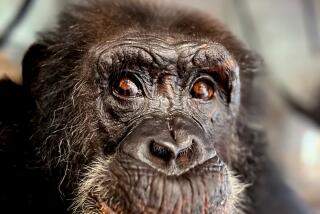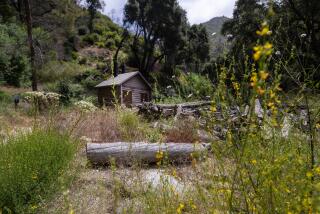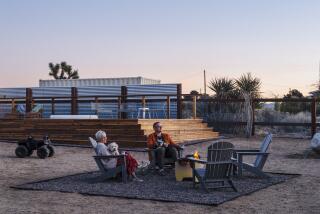Actor Lon Chaney’s Phantom of the Forest
You see it first as a greenish corrugated tin roof hidden in a grove of solid red lodgepole pines. By then, you have hiked three miles, mostly uphill, and are 1,700 feet higher than your starting point 10 miles west of Big Pine in the John Muir Wilderness in the eastern Sierra.
A left fork off the main trail places you below a set of stone steps and a massive stone structure. The idea of such a trek is to get away from civilization. So if you aren’t expecting what’s coming, the 1,288-square-foot granite field stone structure suddenly materializing is a bizarre discovery that, at first glance, can arouse a naturalist’s uneasiness at encountering anything man-made in a wilderness setting.
But the building is no ordinary intrusion. Nor does the U.S. Forest Service sign identifying it as a wilderness ranger cabin begin to explain it. Large locks secure the doors and wooden shutters bar the windows -- all contributing to an air of mystery that seems in keeping with the image of its original owner, Lon Chaney Sr. The actor who starred in “The Hunchback of Notre Dame” and “The Phantom of the Opera,” Chaney was referred to as “the man of a thousand faces,” and for millions of moviegoers in the 1910s and 1920s was the personification of humanity within horror.
Chaney had the stone cabin built for $12,000 in 1929-30. It was designed by Los Angeles architect Paul Revere Williams, the first African American granted a fellowship in the American Institute of Architects. The Saks Fifth Avenue Building in Beverly Hills is an example of one of his public buildings. But Williams is best known for designing private homes, about 2,000 of them, for film celebrities, politicians and other famous people. According to Williams’ granddaughter, Karen Hudson, the Chaney cabin was the only mountain cabin he designed.
Surrounded by steep canyon walls and located amid lodgepole pines in the Inyo National Forest, the cabin faces a creek. Wide stone steps lead up to the one-story rectangular building, its walls 2 feet thick and made of large granite rocks cemented together. There is a gable roof, now covered by corrugated metal, and overhanging 8-inch-thick lodgepole beams.
The interior is divided into one large room and a kitchen separated by a plank wall. There is tongue-in-groove pine flooring, and a granite fireplace in the main room. When Chaney owned the cabin, there was a mounted deer head above the fireplace and a bear rug on the floor. A kerosene lamp on a pulley provided light for the living area and the kitchen.
“Tonight I start out for the High Sierra. No shaving, no makeup, no interviews for four long, lazy weeks. We take a stove along and the wife cooks the fish I catch. We sleep under the pines and I try to climb high enough to reach the snows. Camping’s the biggest kick in life for me,” Chaney told a writer in 1928.
It was no accident that Chaney located the cabin near the Cienega Mirth section of Big Pine Creek, where it curves gently and flattens out. It is one of the best trout fishing spots in the area. Chaney was an ardent fly fisherman and early practitioner of catch and release who had escaped to the area for many years. He camped with his family near the site of the cabin long before he had it built. The glaciated canyon closely resembles the Colorado countryside around Pike’s Peak, where Chaney, as a teenager, led tour groups up the mountain by burro. The fact that there was no road up Big Pine Canyon to the cabin for the last 1 1/2 miles must have appealed to Chaney. He hired pack trains to bring in supplies.
Chaney was to enjoy his cabin for only a few months before his death at age 47. His last trip to the cabin was with his wife, Hazel, in late July 1930. By that time, according to Michael F. Blake’s book, “The Man Behind the Thousand Faces,” Chaney’s bronchial cancer was very advanced. His weakened state, combined with the cabin’s 9,200-foot elevation, made it impossible for him to fish. Continuing hemorrhages forced him to return to Los Angeles, where he died Aug. 26.
The Chaney cabin was built under a government special use permit that allowed Chaney to own the structure while leasing the half-acre site from the federal government. The cabin was sold in 1932, and again in 1955. It reverted to the government in 1980 when the permit expired.
The Forest Service considered destroying the cabin to comply with the 1964 Wilderness Act, which calls for the restoration of natural conditions in wilderness areas. But the agency changed its mind when it became clear that the amount of dynamite required to demolish the massive stone structure would cause major damage to the surrounding trees.
Ultimately, the Forest Service decided that the cabin’s historic value justified its preservation. In 1982, the agency proposed placing the cabin on the Register of Historic Places, but the application process was never completed. The cabin remains on the list of candidates for official designation.
Today, the cabin remains closed to the public, and is seldom used by the Forest Service for shelter or rescue operations. According to Linda Reynolds, a Forest Service historian, there is no money budgeted to maintain the cabin’s interior, even though volunteer groups periodically monitor and maintain its exterior. Forest rangers are concerned that the cabin’s roof might collapse under a heavy snow, despite the huge beams.
Reynolds believes that public intervention may be the only way to ensure the cabin’s survival.
“I think we should have higher visibility -- most people don’t know that there are many archeological and historical sites in the Inyo [National Forest] and they should. Get people involved and maybe we can save some more of them.”
It probably didn’t help that the 1957 film “Man of a Thousand Faces” placed the cabin by a lake and showed Model Ts driving up to the door of a place that is still accessible only by a mountain trail.
More to Read
Sign up for The Wild
We’ll help you find the best places to hike, bike and run, as well as the perfect silent spots for meditation and yoga.
You may occasionally receive promotional content from the Los Angeles Times.






